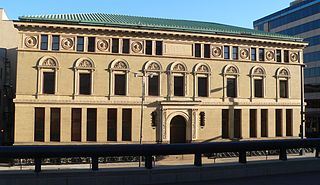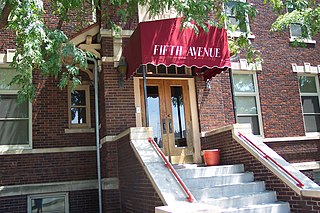
The Webster Telephone Exchange Building is located at 2213 Lake Street in North Omaha, Nebraska. It was designed by the well-known Omaha architect Thomas Rogers Kimball. After the Easter Sunday Tornado of 1913, the building was used as the center of recovery operations. In 1933, American Bell donated the building to the Omaha Urban League.

The Jewell Building is a city landmark in North Omaha, Nebraska. Built in 1923, it is listed on the National Register of Historic Places. Located at 2221 North 24th Street, the building was home to the Dreamland Ballroom for more than 40 years, and featured performances by many touring jazz and blues legends, including Duke Ellington, Count Basie, Louis Armstrong, Dizzy Gillespie, and Lionel Hampton.

Holy Family Church was built in 1883 at 1715 Izard Street, at the intersections of 18th and Izard Streets in North Omaha, Nebraska within the Roman Catholic Archdiocese of Omaha. It is the oldest existing Catholic Church in Omaha, and is listed on the National Register of Historic Places.

The Drake Court Apartments and the Dartmore Apartments Historic District, built between 1916 and 1921, is located at Jones Street from 20th to 23rd Streets in Midtown Omaha, in the U.S. state of Nebraska. Built in combined Georgian Revival, Colonial Revival and Prairie School styles, the complex was designated a City of Omaha Landmark in 1978; it was listed on the National Register of Historic Places as a historic district in 1980. The historic district originally included 6.5 acres (2.6 ha) with 19 buildings. In 2014, boundary of the historic district was expanded by 0.74 acres (0.30 ha) include three additional buildings, and decreased by 3 acres (1.2 ha) to remove open space and parking that had been re-purposed, for a new total of 4.24 acres (1.72 ha). The district was also renamed to Drake Court Historic District.

Saunders School, located at 415 North 41st Avenue in the Midtown area of Omaha, Nebraska, United States, was declared a landmark by the City of Omaha in 1985, and listed on the National Register of Historic Places in 1986.
The Union Stockyards of Omaha, Nebraska, were founded in 1883 in South Omaha by the Union Stock Yards Company of Omaha. A fierce rival of Chicago's Union Stock Yards, the Omaha Union Stockyards were third in the United States for production by 1890. In 1947 they were second to Chicago in the world. Omaha overtook Chicago as the nation's largest livestock market and meat packing industry center in 1955, a title which it held onto until 1971. The 116-year-old institution closed in 1999. The Livestock Exchange Building was listed on the National Register of Historic Places in 1999.

Jobbers Canyon Historic District was a large industrial and warehouse area comprising 24 buildings located in downtown Omaha, Nebraska, US. It was roughly bound by Farnam Street on the north, South Eighth Street on the east, Jackson Street on the south, and South Tenth Street on the west. In 1989, all 24 buildings in Jobbers Canyon were demolished, representing the largest National Register historic district loss to date.

The Christian Specht Building is located at 1110 Douglas Street in downtown Omaha, Nebraska. It is the only existing building with a cast-iron facade known in Nebraska today, and one of the few ever built in the state. The building was deemed an Omaha landmark in 1981, and was listed on the National Register of Historic Places in 1977.

El Museo Latino is a museum featuring Latino and Hispanic art and history that is located at 4701 South 25th Street in South Omaha, Nebraska. Established in 1993, by Magdalena García, it is the first Latino art and history museum and cultural center in the Midwest.

The original Omaha Public Library building was built in 1891 at 1823 Harney Street in downtown Omaha, Nebraska by renowned architect Thomas Kimball. Designed in the Second Renaissance Revival style, the building was designated an Omaha Landmark in October 1978, and was listed on the National Register of Historic Places that same year.

Park School is located at 1320 South 29th Street in south Omaha, Nebraska, United States. The school was designed by Thomas R. Kimball and built in 1918. It was listed on the National Register of Historic Places in 1989 and designated an Omaha Landmark in 1990.

Mason School is located at 1012 South 24th Street in south Omaha, Nebraska, United States. Designed in the Richardson Romanesque style by the architectural firm of Mendelssohn, Fisher and Lawrie, the school was built in 1888 by the brick manufacturing and construction firm of Hadden, Rocheford & Gould. The school closed in the late 1970s and was converted into apartments. It was designated an Omaha Landmark in 1986 and listed on the National Register of Historic Places that same year.

The Eggerss–O'Flyng Building is located at 801 South 15th Street in downtown Omaha, Nebraska, United States. The building was listed on the National Register of Historic Places in 1991, and named an Omaha Landmark on March 17, 1992.

Packer's National Bank Building is located at 4939 South 24th Street in the South Omaha Main Street Historic District in south Omaha, Nebraska. It was built in 1907. In 1984, it was designated an Omaha Landmark and, in 1985, it was listed on the National Register of Historic Places.

The Ford Hospital, also called the Fifth Avenue Hotel, is located at 121 South 25th Street in Midtown Omaha, Nebraska. Built in 1916 by Home Builders Incorporated, the hospital was a privately operated facility built and operated by Dr. Michael J. Ford. Operating until 1922, it was the last small, private hospital in the city. Originally designed by James T. Allan, the building stylistically is unique a blend of elements from the Second Renaissance Revival and the Arts and Crafts movements. The building was sold and remodeled as the Fifth Avenue Hotel in 1929, a name referring to the nickname Douglas Street obtained after the installation of new electric lights in 1927. The building was again converted in 1987, and currently serves as apartments.

The Center School, now known as the Lincoln School Apartments, is located at 1730 South 11th Street in South Omaha, Nebraska, United States. Built in 1893, it was declared an Omaha Landmark June 18, 1985 and listed on the National Register of Historic Places on August 23, 1985.

The Rosewater School, now known as the Rosewater Apartments, is located at 3764 South 13th Street in South Omaha, Nebraska, United States. Built in 1910, the building was named an Omaha Landmark on September 18, 1984, and added to the National Register of Historic Places in 1985.

The Robbins School, originally called Franklin School, is located at 4302 South 39th Avenue in South Omaha, Nebraska, United States. It was built in 1910 to serve a newly established and growing Polish community in south Omaha. A 2000 rehabilitation converted the former school to rental residential use.

The West Farnam Apartments are located at 3817 Dewey Avenue in Midtown Omaha, Nebraska. The building was reportedly the first luxury apartment building constructed in Omaha.















